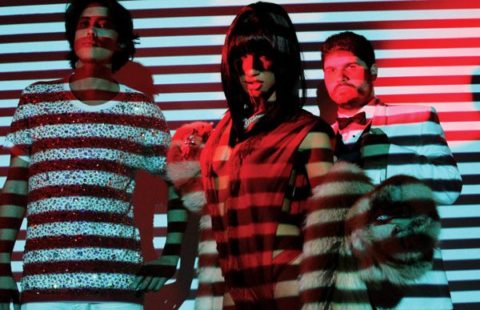Occupy the Dancefloor: How house music, vogue balls and the culture of fierceness are infiltrating fashion, film and pop


It’s 11:30 p.m. on a Friday night in Toronto’s west end. A crowd of twenty- and thirtysomethings are lined up outside La Perla lounge for an event called Her, organized by Frank Griggs—fashion designer Jeremy Laing’s communications director and husband. The looming line looks as though it was pulled from a casting call for a ’90s music video. A guy at the front of the queue—wearing low-rider bell bottoms, champagne-hued fun fur and a CeCe Peniston tour ball cap—is chatting up a young woman dolled up in an apricot catsuit replete with a handbag covered in Keith Haring art pins. Anxious to get their hands stamped, the duo sway to a house remix of En Vogue’s vintage hit “Hold On” blaring from the DJ booth inside. A skinny-jeaned teen sporting a graphic T-shirt that reads “House Music Is The Future” gets out of a cab and joins the pair. “Honey, this is no novelty tee,” he says, pointing to the neon font on his chest. “This is a prophecy tee.”
According to ethnomusicologist Kai Fikentscher, that tee isn’t just a fashion statement, it’s a cultural one. The author of “You Better Work!” Underground Dance Music in New York City claims that house—a soulful branch of electronic music typically set to a 4/4 tempo—is infiltrating nightlife, fashion and film. “After over 20 years of bubbling below the belt of the status quo, house is finally starting to get the global respect and popularity it deserves,” Fikentscher says.
Known for diva-centric vocals, lush strings and syncopated bass, house saw a popularity peak in the late ’80s and early ’90s when hit makers such as Inner City, Crystal Waters and DJ Frankie Knuckles delivered it to radio from its roots in the gay nightclubs of Chicago and New York. Surviving well beyond its older, kitschier sister, disco, house did not die at the hands of grunge—it just moved further into the underground when Nirvana came along. “It has had so many reincarnations and new names,” says Fikentscher, citing nu-disco and electro. “In the past five years, a proper resurrection of [soulful] house has truly been happening.”
The resurgence isn’t just about nostalgia. A new wave of vocalists, songwriters, rappers and designers who weren’t old enough to party in the late ’80s are embracing the sophisticated boom boom. Cutting-edge MCs such as Toronto’s Isis Salam; 23-year-old New Yorker Le1f, who DJed Patrik Ervell’s spring runway show and performed at Opening Ceremony’s 10th anniversary party; and House of Ladosha (they rap about Naomi Campbell’s weave) are experimenting with the look and sound of house, and attracting bigger audiences because of it. Pop names such as Beth Ditto, whose club hit “I Wrote The Book” is a flagrant homage to Madonna’s “Vogue,” Rihanna (her new disc transparently lifts from ’90s DJ duo Masters at Work) and Scissor Sisters have pushed classic, soulful house into the mainstream.
Homegrown success stories abound. Toronto’s Azari & III have been selling out so many live house concerts in Europe that they had to say no to an opening slot on Madonna’s MDNA tour. Toronto-born DJ Adam Marshall’s dance music label New Kanada has signed a roster that caters to hardcore house aficionados and is gaining international attention: Murr (the artist behind a fantastic ode to eveningwear called “My Best Dress”) and Diva are breaking into clubs as far and wide as Germany, Russia and the Netherlands.
“House music has kept a whole culture alive,” says 26-year-old Travoy Deer. He’s one of the organizers of Toronto’s largest vogue balls, where dancers compete in what are known as walk-offs. “This music isn’t just the soundtrack to fashion runways, it’s the soundtrack to a whole heritage of voguers.”
Recognized for face framing, muscle popping, floor dipping, rhythm stepping and pose striking, vogue dancers take movements from Egyptian hieroglyphics and gymnastics, and strive to create perfect lines with their bodies. Walk-offs are a fun house nod to the past and present catwalks of Paris, New York and Milan. The dance floor becomes a makeshift runway where voguers try to out-fierce one another in categories connected to fashion, gender and sexuality, like European Runway, Sex Siren and Butch Queen.
“Unlike the rest of the world, we are not just obsessed with celebrities. We have not given up on supermodels—the Tyras,
Naomis and Imans,” says Deer, who became “mother” (a.k.a. troop leader) of his house, the House of Monroe, in 2007. “They are inspirational goddesses to us because vogueing is about giving it all with an attitude and look. The glamorous fashion moments we want to outdo are from these supermodels—we’ve learned that from previous generations of voguers.” Attendance at Deer’s glam-packed events has tripled since 2009—a trend seen at vogue balls in Atlanta and New York; now the House of Monroe is planning on touring Canada and producing a movie not unlike 1990’s Paris is Burning, a documentary about the vogue houses of New York.
“We definitely feel it’s our time to shine,” Deer says. “When I think about the changes in the House of Munroe, especially the number of straight and LGBTQ women of all shapes, colours and sexualities who have become vogueing fanatics and joined the house, it’s crazy. Although it started with and still includes drag queens and gay men, the house isn’t only about them anymore. Recently we’ve had to come up with a vogue ball for women only [scheduled for May in Toronto] to accommodate numbers. We even do small events outside of the clubs now. We have had kids as young as 13 learn how to dance and do walk-offs.”
New York house singer/DJ/producer/designer Kim Ann Foxman features vogue dancers in the video for her club hit “Return It.” “Every new generation is obsessed with the era that they were born in,” she says. “So many artists who were born in the ’70s loved Studio 54 and disco and all that stuff—they were drawn to it. Today, it’s all about house and vogue balls.” Having had success as a solo artist with house cuts such as “What You Need” and “Creature,” Foxman is one of the most innovative leaders of the dance music pack. She left Hercules and Love Affair in 2011 to create her own brand of house, and now travels more than eight months a year to DJ fashion parties, runway shows and clubs around the world.
One of Foxman’s past collaborators, Nomi Ruiz, has also formed a successful music and fashion career via house. She became Mugler creative director Nicola Formichetti’s muse—her band Jessica 6’s song “White Horse” was featured in the brand’s Spring 2012 campaign—and now the transgender model/singer is in the studio recording her group’s sophomore disc. “While disco was thought to be music for the sexual revolution, I always see house as music for the sensual revolution,” says Ruiz. “That’s why fashion keeps falling in love with it and playing it on the runway, I think even more than in the ’90s.”
As new-schoolers revisit the genre on their own terms, pioneers such as Lady Miss Kier have been given a boost by house’s renovation. After nearly two decades, the voice of Deee-Lite hits such as “Groove Is In The Heart” (and an inspiration for a collection of New York’s Made Me streetwear) is gearing up to release an album of new material.
“When I was with Deee-Lite on a major label, they told me that our music was too black and too gay and would never sell,” she says. “Meanwhile, it’s what so many fashion people fed off and still feed off for inspiration and it’s only gotten stronger. It’s so strong that young people are exploring the history of it too, which is good for everyone.”







